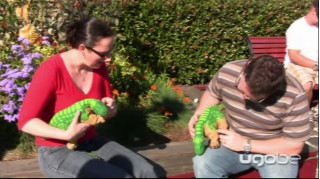Steve Gill is visiting so that we can work together on a new book on physicality. Last night, over dinner, Steve was telling us about a litter-bin lock that he once designed. The full story linked creative design, the structural qualities of materials, and the social setting in which it was placed … a story well worth hearing, but I’ll leave that to Steve.
One of the critical things about the design was that while earlier designs used steel, his design needed to be made out of plastic. Steel is an obvious material for a lock: strong unyielding; however the plastic lock worked because the lock and the bin around it were designed to yield, to give a little, and is so doing to absorb the shock if kicked by a drunken passer-by.
This is a sort of Judo principle of design: rather than trying to be the strongest or toughest, instead by yielding in the right way using the strength of your opponent.
This reminded me of trees that bend in the wind and stand the toughest storms (the wind howling down the chimney maybe helps the image), whereas those that are stiffer may break. Also old wooden pit-props that would moan and screech when they grew weak and gave slightly under the strain of rock; whereas the stronger steel replacements would stand firm and unbending until the day they catastrophically broke.
 Years ago I also read about a programme to strengthen bridges as lorries got heavier. The old arch bridges had an infill of loose rubble, so the engineers simply replaced this with concrete. In a short time the bridges began to fall down. When analysed more deeply the reason become clear. When an area of the loose infill looses strength, it gives a little, so the strain on it is relieved and the areas around take the strain instead. However, the concrete is unyielding and instead the weakest point takes more and more strain until eventually cracks form and the bridge collapses. Twisted ropes work on the same principle. Although now an old book, “The New Science of Strong Materials” opened my eyes to the wonderful way many natural materials, such as bone, make use of the relative strengths, and weaknesses, of their constituents, and how this is emulated in many composite materials such as glass fibre or carbon fibre.
Years ago I also read about a programme to strengthen bridges as lorries got heavier. The old arch bridges had an infill of loose rubble, so the engineers simply replaced this with concrete. In a short time the bridges began to fall down. When analysed more deeply the reason become clear. When an area of the loose infill looses strength, it gives a little, so the strain on it is relieved and the areas around take the strain instead. However, the concrete is unyielding and instead the weakest point takes more and more strain until eventually cracks form and the bridge collapses. Twisted ropes work on the same principle. Although now an old book, “The New Science of Strong Materials” opened my eyes to the wonderful way many natural materials, such as bone, make use of the relative strengths, and weaknesses, of their constituents, and how this is emulated in many composite materials such as glass fibre or carbon fibre.
In contrast both software and bureaucratic procedures are more like chains – if any link breaks the whole thing fails.
Steve’s lock design shows that it is possible to use the principle of strength in weakness when using modern materials, not only in organic elements like wood, or traditional bridge design. For software also, one of the things I often try to teach is to design for failure – to make sure things work when they go wrong. In particular, for intelligent user interfaces the idea of appropriate intelligence – making sure that when intelligent algorithms get things wrong, the user experience does not suffer. It is easy to want to design the cleverest algotithms, the most complex systems – to design for everything, to make it all perfect. While it is of course right to seek the best, often it is the knowledge that what we produce will not be ‘perfect’ that in fact enables us to make it better.



